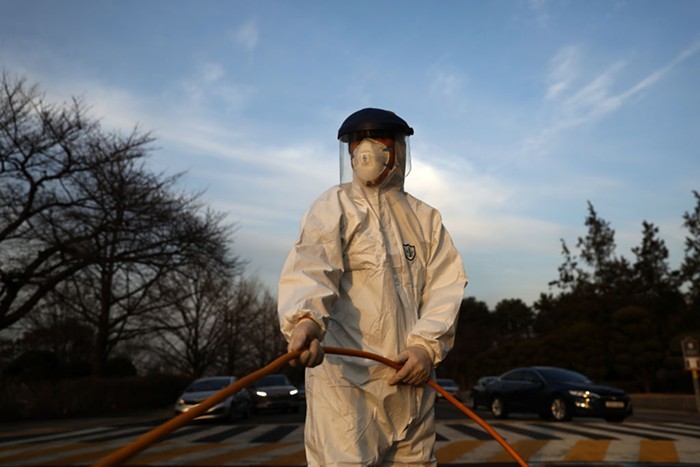
Reports are coming in from around Puget Sound that people seeking tests for COVID-19 are unable to get them.
One of those reports come from Jeannette Jameson, a 61-year-old Mill Creek resident who has been experiencing an undiagnosed respiratory illness for about a month.
“I'm a criminal defense lawyer and I'm in the court every day, and I'm in the jail every day, and I'm also in mental hospitals because I represent some people who've been involuntarily committed,” she told me in a phone interview. “I come in close contact with people every day.”
That, in part, is what led Jameson to worry she might be infected with COVID-19, the novel coronavirus that has caused at least nine deaths in Washington state. She’s not just concerned about possibly having the virus herself, but also with the possibility that she’s unknowingly transmitted it to other people, especially those who live confined in large populations like prisons.
At the onset of her illness, Jameson says, she sought care at an urgent care facility that’s located near a high school in Mill Creek that has reported at least one confirmed case of COVID-19 in a student. She was diagnosed with bronchitis at the urgent care and prescribed antibiotics, but her health continued to decline, and so this week she contacted her primary care physician to inquire about getting tested for COVID-19.
“She called back and said, ‘I want you to go to the ER and get tested for coronavirus,’” Jameson told me. “I said I didn't want to go to the ER because my immune system is so compromised right now, and I have type 2 diabetes, and I don’t want to be exposed to coronavirus if I don't already have it. She said, 'I will call ahead and they will take you straight back. You won't be in the waiting room.' I’m crying because I don’t want to go to the ER so badly, but she tells me I have to go and they’ll see me immediately."
That’s not what happened, according to Jameson. On Monday, she went to the Providence Regional Medical Center in Everett, and she says there were probably about 100 people seeking care in the ER, most wearing face masks. When she told the intake officers she was there for a coronavirus test and didn’t want to be in the waiting room surrounded by sick people, she was instructed to sit on a bench outside the waiting room.
After two hours of waiting, Jameson was finally called back. “They take me about 15 feet from where I was sitting and stick me in a chair in the middle of two office partitions, the kind that are covered in carpet and designed for office cubicles,” she said. “They are not smooth surfaces, they are not hygienic, there is no way they are cleaning that between patients. And it's right in the hallway where everyone is walking back and forth. It’s like a third world country in there.”
After another half an hour, she says a nurse practioner gave her a flu test and later returned with the results. “He says, ‘Good news: You don't have the flu.’ I say, ‘I came for a coronavirus test. My doctor sent me here for a coronavirus test.’ And he says, 'We're not giving anyone a coronavirus test unless they are admitted to the hospital with severe symptoms. You should be happy you don't have the flu. There's something in your lungs but it's not bad enough to admit you.’”
Jameson says that in total, she was at the ER for about four hours and was never given a test for coronavirus.
(The Stranger reached out to Providence Regional Medical Center for comment but has not yet heard back.)
Jameson’s experience isn’t surprising. According to state officials, local labs currently have the capacity to test only between 100 and 200 patients a day. That number is expected to go up within the coming days and weeks, but as my colleague Lester Black reported this morning, the claim by Trump administration officials that manufacturers will have the capacity to ship a million coronavirus tests by the end of the week are directly contradicted by the manufacturers that are supposed to be providing them.
With the virus—and panic about the virus—rapidly spreading throughout the nation, more and more people are seeking tests that they will not be given. So what are people supposed to do if they are experiencing symptoms?
According to a spokesperson for UW Medicine, people should do exactly what Jameson did: Contact their doctors first, and if their doctors tell them to, seek care at the emergency room. This is the same advice Public Health — Seattle & King County is giving local residents. But as Jameson’s experience shows, emergency rooms aren’t equipped to handle a flood of people seeking care, and those emergency rooms themselves can become vectors of infection, putting even more people at risk.
“It's just crazy,” Jameson said. “It seems to me we're going to have very low numbers of people diagnosed because nobody is getting tested.” She says that she’s not sure what she’s going to do next besides stay home, avoid other people, and hope she recovers.
“Before I left the ER yesterday they told me I was diagnosed with a 'nonspecific respiratory illness' and they gave me two prescriptions,” she says. “One was for Motrin and one was for Tylenol. They might as well have written ‘FU’ on the prescription. I can't wait to see how much they bill me.”


















